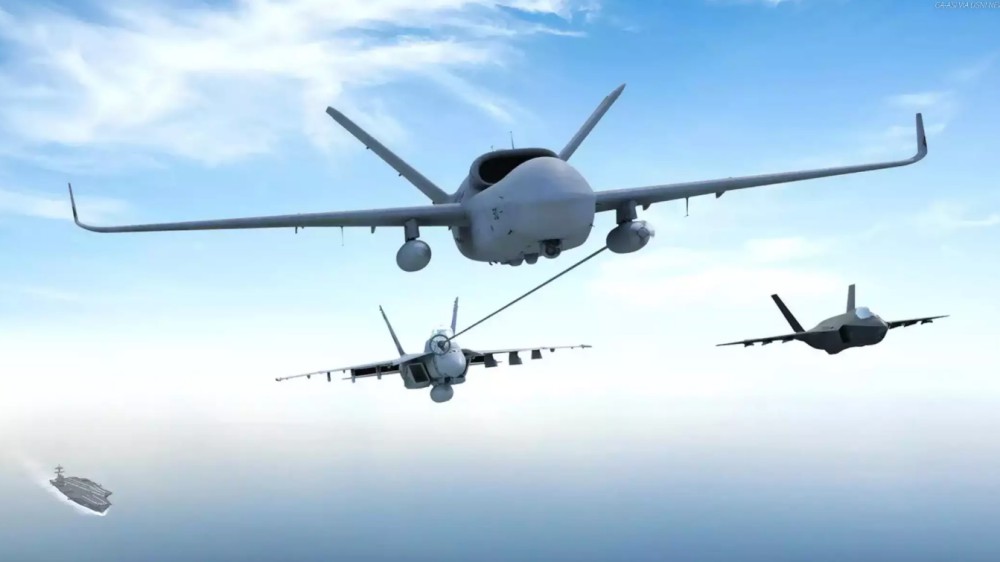General Atomics has announced it will team up with Boeing to compete for the contract to build the first four MQ-25 Stingray carrier-based tanker drones for the U.S. Navy if it wins the competition, though the latter firm says it will also pursue its own individual proposal, as well.
This follows the service dropping something of a bombshell in its latest budget request, stating that, at best, it will only buy four of the Stingrays over the next six years and that a possible larger buy of 68 will only come some time after that, if it happens at all.
After talking with General Atomics MQ-25 program manager Chuck Wright and communications manager Melissa Haynes we got a clearer view as to why the company paired with Boeing, one of its primary competitors for the MQ-25 tender, as well as what we can expect from their UCA design.
Wright made it clear that in his opinion Boeing is going forward with the pairing because it increases their chances of some sort of a win when it comes to the MQ-25 competition, stating “winning the whole thing is great, but a slice of a team is also great too.” Considering Boeing apparently sees this as a must win for them, hedging by agreeing to work with General Atomics if they are victorious does make good sense.
During our conversation, Chuck Wright laid out a number of reasons why General Atomics saw it as beneficial to add Boeing to their MQ-25 team. These included the fact that Boeing has a large unused facility that would be well suited for producing the MQ-25—a major expense saved if General Atomics were to win the MQ-25 competition—and that it could also potentially facilitate the production of other systems in the future. Boeing highly diverse manufacturing expertise was also not lost on General Atomics.
The fact that Boeing has a long standing relationship with the Navy and has huge experience particularly in the systems integration, aircraft test and evaluation, and carrier suitability space is seen as a huge benefit should General Atomics get the shot at executing on their MQ-25 proposal. As Wright put it, Boeing has a “well deserved reputation for knowing what needs to be done” when it comes to bringing a naval aviation program through to fruition, especially one that has to operate in the confines and harsh environment of an aircraft’s carrier’s deck and hangar bay.
Above all else, the two defense contractors have been talking for years about how and when to cooperate on new mutually beneficial projects, and General Atomics’ MQ-25 initiative seemed to suit the bill nicely.
As for the company’s MQ-25 prototype itself, which we have only seen in artists renderings as of yet, it is slated to be unveiled in just two months.
Like all the UCA competitors, General Atomics had worked hard on developing an aircraft to satisfy the Navy’s earlier UCLASS requirements, which was for a more advanced penetrating reconnaissance and strike unmanned aircraft. Then the seagoing service canceled that set of requirements in favor of an unmanned tanker with much more limited surveillance capabilities and no strike or penetrating abilities at all. As such, its design emanates from the Sea Avenger UCLASS concept, which itself was a derivative of the stealthy Predator C/Avenger land-based unmanned aircraft that has been flying for years.
But it’s not like General Atomics UCA entrant is just an Avenger with a tailhook and a buddy refueling pod slapped on it. The highly altered design came to be thanks to advanced software tools where engineers could reconfigure nearly limitless iterations of the basic design based on many variables and requirements.
Since the Navy wants the aircraft to “carry a lot of fuel, a long ways” as Wright put it, major changes like a much more voluminous overall design and more efficient powerplant came into play. Wright says the General Atomics engineers built a lot of margin into their design as well and really optimized it as best as possible to meet the UCA mission.
For a more through analysis of the question, read the full article here.
Source: The Drive

